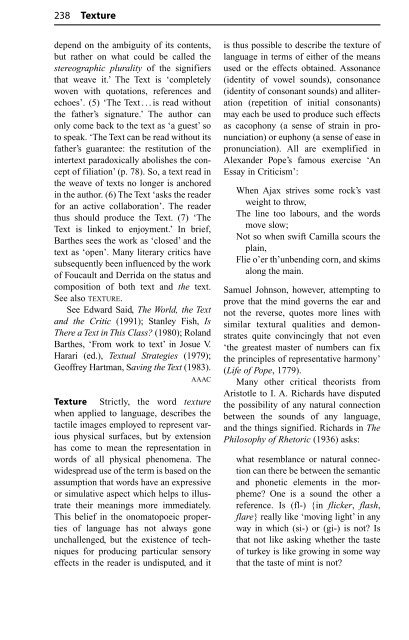The Routledge Dictionary of Literary Terms
The Routledge Dictionary of Literary Terms
The Routledge Dictionary of Literary Terms
Create successful ePaper yourself
Turn your PDF publications into a flip-book with our unique Google optimized e-Paper software.
238 Texture<br />
depend on the ambiguity <strong>of</strong> its contents,<br />
but rather on what could be called the<br />
stereographic plurality <strong>of</strong> the signifiers<br />
that weave it.’ <strong>The</strong> Text is ‘completely<br />
woven with quotations, references and<br />
echoes’. (5) ‘<strong>The</strong> Text...is read without<br />
the father’s signature.’ <strong>The</strong> author can<br />
only come back to the text as ‘a guest’ so<br />
to speak. ‘<strong>The</strong> Text can be read without its<br />
father’s guarantee: the restitution <strong>of</strong> the<br />
intertext paradoxically abolishes the concept<br />
<strong>of</strong> filiation’ (p. 78). So, a text read in<br />
the weave <strong>of</strong> texts no longer is anchored<br />
in the author. (6) <strong>The</strong> Text ‘asks the reader<br />
for an active collaboration’. <strong>The</strong> reader<br />
thus should produce the Text. (7) ‘<strong>The</strong><br />
Text is linked to enjoyment.’ In brief,<br />
Barthes sees the work as ‘closed’ and the<br />
text as ‘open’. Many literary critics have<br />
subsequently been influenced by the work<br />
<strong>of</strong> Foucault and Derrida on the status and<br />
composition <strong>of</strong> both text and the text.<br />
See also TEXTURE.<br />
See Edward Said, <strong>The</strong> World, the Text<br />
and the Critic (1991); Stanley Fish, Is<br />
<strong>The</strong>re a Text in This Class? (1980); Roland<br />
Barthes, ‘From work to text’ in Josue V.<br />
Harari (ed.), Textual Strategies (1979);<br />
Ge<strong>of</strong>frey Hartman, Saving the Text (1983).<br />
AAAC<br />
Texture Strictly, the word texture<br />
when applied to language, describes the<br />
tactile images employed to represent various<br />
physical surfaces, but by extension<br />
has come to mean the representation in<br />
words <strong>of</strong> all physical phenomena. <strong>The</strong><br />
widespread use <strong>of</strong> the term is based on the<br />
assumption that words have an expressive<br />
or simulative aspect which helps to illustrate<br />
their meanings more immediately.<br />
This belief in the onomatopoeic properties<br />
<strong>of</strong> language has not always gone<br />
unchallenged, but the existence <strong>of</strong> techniques<br />
for producing particular sensory<br />
effects in the reader is undisputed, and it<br />
is thus possible to describe the texture <strong>of</strong><br />
language in terms <strong>of</strong> either <strong>of</strong> the means<br />
used or the effects obtained. Assonance<br />
(identity <strong>of</strong> vowel sounds), consonance<br />
(identity <strong>of</strong> consonant sounds) and alliteration<br />
(repetition <strong>of</strong> initial consonants)<br />
may each be used to produce such effects<br />
as cacophony (a sense <strong>of</strong> strain in pronunciation)<br />
or euphony (a sense <strong>of</strong> ease in<br />
pronunciation). All are exemplified in<br />
Alexander Pope’s famous exercise ‘An<br />
Essay in Criticism’:<br />
When Ajax strives some rock’s vast<br />
weight to throw,<br />
<strong>The</strong> line too labours, and the words<br />
move slow;<br />
Not so when swift Camilla scours the<br />
plain,<br />
Flie o’er th’unbending corn, and skims<br />
along the main.<br />
Samuel Johnson, however, attempting to<br />
prove that the mind governs the ear and<br />
not the reverse, quotes more lines with<br />
similar textural qualities and demonstrates<br />
quite convincingly that not even<br />
‘the greatest master <strong>of</strong> numbers can fix<br />
the principles <strong>of</strong> representative harmony’<br />
(Life <strong>of</strong> Pope, 1779).<br />
Many other critical theorists from<br />
Aristotle to I. A. Richards have disputed<br />
the possibility <strong>of</strong> any natural connection<br />
between the sounds <strong>of</strong> any language,<br />
and the things signified. Richards in <strong>The</strong><br />
Philosophy <strong>of</strong> Rhetoric (1936) asks:<br />
what resemblance or natural connection<br />
can there be between the semantic<br />
and phonetic elements in the morpheme?<br />
One is a sound the other a<br />
reference. Is (fl-) {in flicker, flash,<br />
flare} really like ‘moving light’ in any<br />
way in which (si-) or (gi-) is not? Is<br />
that not like asking whether the taste<br />
<strong>of</strong> turkey is like growing in some way<br />
that the taste <strong>of</strong> mint is not?

















